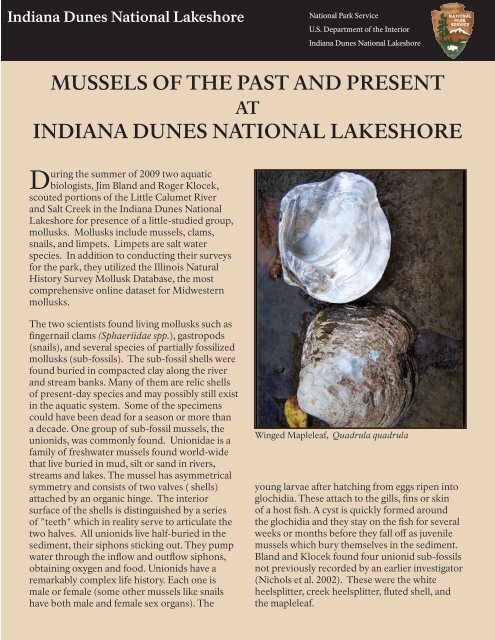mussels of the past and present indiana dunes national lakeshore
mussels of the past and present indiana dunes national lakeshore
mussels of the past and present indiana dunes national lakeshore
You also want an ePaper? Increase the reach of your titles
YUMPU automatically turns print PDFs into web optimized ePapers that Google loves.
Indiana Dunes National Lakeshore<br />
National Park Service<br />
U.S. Department <strong>of</strong> <strong>the</strong> Interior<br />
Indiana Dunes National Lakeshore<br />
MUSSELS OF THE PAST AND PRESENT<br />
AT<br />
INDIANA DUNES NATIONAL LAKESHORE<br />
During <strong>the</strong> summer <strong>of</strong> 2009 two aquatic<br />
biologists, Jim Bl<strong>and</strong> <strong>and</strong> Roger Klocek,<br />
scouted portions <strong>of</strong> <strong>the</strong> Little Calumet River<br />
<strong>and</strong> Salt Creek in <strong>the</strong> Indiana Dunes National<br />
Lakeshore for presence <strong>of</strong> a little-studied group,<br />
mollusks. Mollusks include <strong>mussels</strong>, clams,<br />
snails, <strong>and</strong> limpets. Limpets are salt water<br />
species. In addition to conducting <strong>the</strong>ir surveys<br />
for <strong>the</strong> park, <strong>the</strong>y utilized <strong>the</strong> Illinois Natural<br />
History Survey Mollusk Database, <strong>the</strong> most<br />
comprehensive online dataset for Midwestern<br />
mollusks.<br />
The two scientists found living mollusks such as<br />
fingernail clams (Sphaeriidae spp.), gastropods<br />
(snails), <strong>and</strong> several species <strong>of</strong> partially fossilized<br />
mollusks (sub-fossils). The sub-fossil shells were<br />
found buried in compacted clay along <strong>the</strong> river<br />
<strong>and</strong> stream banks. Many <strong>of</strong> <strong>the</strong>m are relic shells<br />
<strong>of</strong> <strong>present</strong>-day species <strong>and</strong> may possibly still exist<br />
in <strong>the</strong> aquatic system. Some <strong>of</strong> <strong>the</strong> specimens<br />
could have been dead for a season or more than<br />
a decade. One group <strong>of</strong> sub-fossil <strong>mussels</strong>, <strong>the</strong><br />
unionids, was commonly found. Unionidae is a<br />
family <strong>of</strong> freshwater <strong>mussels</strong> found world-wide<br />
that live buried in mud, silt or s<strong>and</strong> in rivers,<br />
streams <strong>and</strong> lakes. The mussel has asymmetrical<br />
symmetry <strong>and</strong> consists <strong>of</strong> two valves ( shells)<br />
attached by an organic hinge. The interior<br />
surface <strong>of</strong> <strong>the</strong> shells is distinguished by a series<br />
<strong>of</strong> "teeth" which in reality serve to articulate <strong>the</strong><br />
two halves. All unionids live half-buried in <strong>the</strong><br />
sediment, <strong>the</strong>ir siphons sticking out. They pump<br />
water through <strong>the</strong> inflow <strong>and</strong> outflow siphons,<br />
obtaining oxygen <strong>and</strong> food. Unionids have a<br />
remarkably complex life history. Each one is<br />
male or female (some o<strong>the</strong>r <strong>mussels</strong> like snails<br />
have both male <strong>and</strong> female sex organs). The<br />
Winged Mapleleaf, Quadrula quadrula<br />
young larvae after hatching from eggs ripen into<br />
glochidia. These attach to <strong>the</strong> gills, fins or skin<br />
<strong>of</strong> a host fish. A cyst is quickly formed around<br />
<strong>the</strong> glochidia <strong>and</strong> <strong>the</strong>y stay on <strong>the</strong> fish for several<br />
weeks or months before <strong>the</strong>y fall <strong>of</strong>f as juvenile<br />
<strong>mussels</strong> which bury <strong>the</strong>mselves in <strong>the</strong> sediment.<br />
Bl<strong>and</strong> <strong>and</strong> Klocek found four unionid sub-fossils<br />
not previously recorded by an earlier investigator<br />
(Nichols et al. 2002). These were <strong>the</strong> white<br />
heelsplitter, creek heelsplitter, fluted shell, <strong>and</strong><br />
<strong>the</strong> mapleleaf.
In Conclusion:<br />
The scientists concluded that <strong>the</strong> Dunel<strong>and</strong>s<br />
s<strong>and</strong>y soils provide <strong>the</strong> streambeds with<br />
large quantities <strong>of</strong> s<strong>and</strong>, which are inherently<br />
unstable. The mussel fauna is reminiscent <strong>of</strong><br />
unique habitats in headwater streams <strong>of</strong> <strong>the</strong><br />
Midwest, where <strong>the</strong>y adapted to rapidly shifting<br />
substrate. The sub-fossil species re<strong>present</strong> a<br />
potential species suite for <strong>the</strong> Little Calumet<br />
River.<br />
For more information, contact:<br />
Roger Klocek<br />
OpenL<strong>and</strong>s<br />
25 E. Washington<br />
Chicago, IL 60602<br />
rklocek@huffnhuff.com<br />
James Bl<strong>and</strong><br />
23 North Lake Avenue<br />
Third Lake, Illinois 60030<br />
EPS Inc.<br />
ilmbl<strong>and</strong>@comcast.net<br />
The list <strong>of</strong> <strong>the</strong> unionid mussel species found in<br />
2009 (*) <strong>and</strong> in historic collections(**) from <strong>the</strong><br />
Indiana Dunes National Lakeshore includes:<br />
Slippershell, Alasmidonta viridis*<br />
Threeridge, Amblema plicata* **<br />
Cylindrical papershell, Anodontoides ferussacianus*<br />
Spike, Elliptio dilatata* **<br />
Wabash pigtoe, Fusconaia flava*<br />
Plain pocketbook, Lampsilis cardium* **<br />
Fatmucket, Lampsilis siliquoidea* **<br />
White heelsplitter, Lasmigona complanata**<br />
Creek heelsplitter, Lasmigona compressa**<br />
Fluted shell, Lasmigona costata**<br />
Round Pigtoe, Pleurobema sintoxia* **<br />
Mapleleaf, Quadrula quadrula**<br />
Ellipse, Venustaconcha ellipsiformis*<br />
Total Number <strong>of</strong> Live Native Mussel Species = 0<br />
Total Number <strong>of</strong> Relic Native Mussel Species = 13<br />
Two exotic species known to occur in <strong>the</strong> area<br />
were NOT FOUND during <strong>the</strong> survey:<br />
Asiatic clam - Corbicula fluminea - EXOTIC<br />
Zebra mussel - Dreissena polymorpha - EXOTIC<br />
References:<br />
Midwest. Illinois Natural History Survey, Manual 5. 194 pp.<br />
http://www.museum.state.il.us/ismdepts/zoology/<strong>mussels</strong>/gallery.html?TopicID=Paleoheterodonta<br />
Illinois State Museum. Mussel Photo ID pages online database.<br />
http://www.inhs.uiuc.edu/cbd/collections/mollusk/molluskintro.html<br />
Illinois Natural History Survey Mollusk database<br />
2002. S. J. Nichols, G. Kennedy, G. Black, J. Allen. Status <strong>of</strong> Freshwater Unionid<br />
Populations at Indiana Dunes National Lakeshore. 2002. U.S. Geological Survey, Great<br />
Lakes Science Center. Ann Arbor, MI. p1- 40.<br />
2008. Klocek, Roger, Bl<strong>and</strong>, James, Barghusen, Laura. Field Guide to <strong>the</strong> Mussels <strong>of</strong> <strong>the</strong><br />
Chicago Wilderness. Chicago Wilderness Publications. P iii-84. <strong>and</strong> online at:<br />
http://fm2.fieldmuseum.org/plantguides/guideimages.asp?ID=360
















